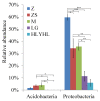The gut microbiota diversity of five Orthoptera (Insecta, Polyneoptera) insects determined by DNA metabarcoding
- PMID: 38327358
- PMCID: PMC10848783
- DOI: 10.3897/BDJ.11.e98162
The gut microbiota diversity of five Orthoptera (Insecta, Polyneoptera) insects determined by DNA metabarcoding
Abstract
Most orthopteran insects are phytophagous and some are important pests in agriculture and forests. Many intestinal microflora of Orthoptera insects have been reported, primarily from Acridoidea and there have been few reports of other taxa. In this study, we collected 15 individuals representing five species (Ruspolialineosa, Tetrixjaponica, Erianthusversicolor, Gryllotalpaorientalis and Teleogryllusemma) belonging to five orthopteran superfamilies (Tettigonioidea, Tetrigoidea, Eumastacoidea, Gryllotalpoidea and Grylloidea) to characterise and compare the gut microbiota with greater taxonomic width by performing sequencing analysis of the 16S rRNA V4 region in gut material. A total of 606,053 high-quality sequences and 3,105 OTUs were acquired from 15 gut samples representing 24 phyla, 48 classes, 69 orders, 133 families and 219 genera. Firmicutes and bacteria were the most abundant phyla, followed by Bacteroidetes, Cyanobacteria, Actinobacteria and Acidobacteria. At the genus level, Serratia, Citrobacter, Wolbachia, Lactobacillus and Parabacteroides were the most predominant genera in R.lineosa, T.japonica, E.versicolor, G.orientalis and T.emma, respectively. Both Principal Coordinates Analysis (PCoA) and heatmap results revealed significant differences in bacterial community composition across species. Additionally, alpha diversity analysis indicated the bacterial richness was significantly different amongst the five species.
Keywords: DNA metabarcoding; Orthoptera; biodiversity; gut microbiota.
Yantong Liu, Lina Zhao, Zhongying Qiu, Hao Yuan.
Figures





References
-
- Ademolu Kehinde O, Idowu Adewunmi B. Occurrence and distribution of microflora in the gut regions of the variegated grasshopper Zonocerusvariegatus (Orthoptera: Pyrgomorphidae) during development. Zoological Studies. 2011;50(4):409–415.
-
- Amato Katherine R, Yeoman Carl J, Kent Angela, Righini Nicoletta, Carbonero Franck, Estrada Alejandro, Rex Gaskins H, Stumpf Rebecca M, Yildirim Suleyman, Torralba Manolito. Habitat degradation impacts black howler monkey (Alouattapigra) gastrointestinal microbiomes. The ISME Journal. 2013;7(7):1344–1353. doi: 10.1038/ismej.2013.16. - DOI - PMC - PubMed
-
- Anderson Kirk E, Sheehan Timothy H, Mott Brendon M, Maes Patrick, Snyder Lucy, Schwan M R, Walton Alexander, Jones B M, Corby-Harris Vanessa. Microbial ecology of the hive and pollination landscape: bacterial associates from floral nectar, the alimentary tract and stored food of honey bees (Apismellifera) PLOS One. 2013;8(12) doi: 10.1371/journal.pone.008312. - DOI - PMC - PubMed
LinkOut - more resources
Full Text Sources
